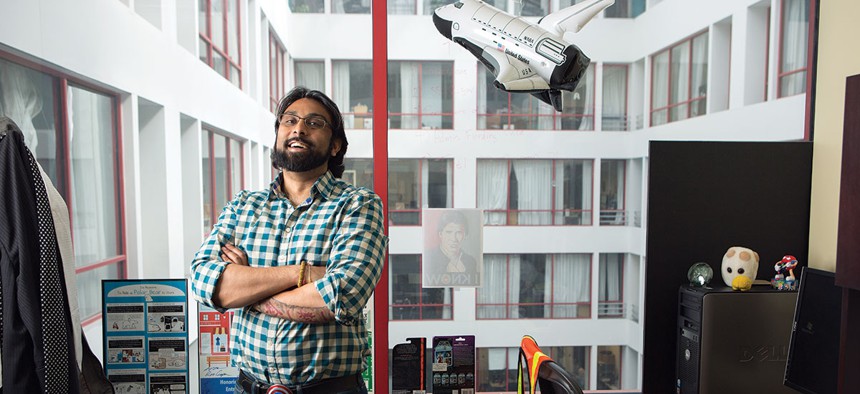
Willis Bretz
Government’s Own Venture Capitalist
Nagesh Rao plants seed money for small business startups that can pioneer breakthroughs in energy, science and medicine.
Nagesh Rao is living in the future—10, sometimes 15 years out.
He’s on the lookout for small businesses on the verge of uncovering big tech trends. He doesn’t care about the next hot smartphone app. Instead, he’s searching for emerging technology that could transform industries—clean energy, life sciences, transportation, among others—more than a decade from now.
Rao isn’t a venture capitalist, though at the Small Business Administration he serves a similar purpose. As SBA’s chief technology officer, also known as the “nerd-in-residence,” Rao oversees the Small Business Investment Research grant program, which helps companies research concepts that could eventually be commercialized.
SBIR recipients include Ecovative Design, a Green Island, New York-based company that develops biodegradable packaging intended to replace Styrofoam using mushroom tissue. Dell uses Ecovative’s Mushroom Packaging to ship its servers. Two years ago, NASA awarded an SBIR grant to
Austin, Texas-based Systems and Materials Research Consultancy, which is studying the feasibility of 3-D printing food in space.
Unlike venture investments, which are often in exchange for a stake in the company, SBIR grants are what Rao calls “patient capital”—not seeking returns on the investment and not seeking ownership of the company or intellectual property, but waiting to see what develops.
Rao returned to government a year and a half ago, after a stint with industry. He worked for Stiefel Family Foundation and consulted with companies like Planet Labs. He still is an adviser to LAUNCH, a business accelerator started by NASA, the U.S. Agency for International Development, the State Department and Nike. Earlier, he worked at the Commerce Department, where his roles included policy adviser at the U.S. Patent and
Trademark Office.
Government Executive staff correspondent Mohana Ravindranath chatted with Rao recently about the government’s role in nurturing innovation. Here are edited excerpts from that conversation.
What kind of innovation are you looking to fund?
When everyone thinks “tech,” it automatically takes on this agnostic, universal meaning, and it’s not true. You get a lot of people who see these social media companies like Facebook, LinkedIn, Whatsapp, and they say “I’ll make an app and that’ll be it.”
We’re interested in life-saving drugs, we’re interested in next generation vehicles, next generation energy solutions. If you’re looking to finance an app, this is probably not the program for you. But if you’re looking to find the next cure for cancer, then yeah, come to us.
So you’re kind of like Silicon Valley’s early stage investors?
We’re looking five to 10 years ahead of Silicon Valley, [though SBIR] operates on a Silicon Valley model on the notion of seed financing. A Phase 1 grant is up to $150,000—that’s usually like your angel investment. And Phase 2, which is usually about $1 million or $1.5 million, is your Series A.
The program does a lot of technological de-risking. The government is filling a void where the free market’s not going to touch that technology’s development. We’ll finance it, we’ll take on that risk, and take on a little bit more of that technological due diligence up front. Then we carry you on to a certain point, and thereafter let the free market take rein as to what’s going to be adopted and what isn’t.
When that technology becomes mainstream, we kind of get forgotten about. Once it’s been de-risked to a point and the free market’s playing it really well, we’ll take a step back and look at other areas we need to finance.
You’ll see a lot of VCs look at SBIR-funded companies and say, “Oh, that looks like it’s much more mature and ready to go, so yeah, let’s take a bet on it.” Peter Thiel from [early-stage grant fund] Breakout Labs has been doing that; Modern Meadow [a startup that 3-D prints meat] is SBIR financed.
Is it tough to convince startups to apply for federal funding?
There is a little bit of that notion that government’s not cool to work with.
[SBIR grants are] taxpayer dollars, so it requires a little bit more paperwork and oversight and it can be a bit more bureaucratic for small companies.
How do you get the government to embrace a culture of innovation?
I understood government culture having worked in it, starting at the bottom of the ladder as a GS-7. I climbed my way up before I decided to leave and take on something a bit more risky and exciting.
And it wasn’t that government wasn’t exciting. Government is very exciting. It’s just that if you’re looking to do really positive change, government tends to have to play, at times, lagging.
It will be leading, but it has to also play lagging, because you’re talking about policy changes that impact 300 million people.
Silicon Valley—and I still go back there pretty frequently—is definitely on a very different time scale of rapid development. Silicon Valley is like, “We’re here to be very disruptive and change the world.” But it tends to be its own little ecosystem, its own little mini-world. [My job involves] embracing
that notion of change and embracing that notion of disruption, but at the same time doing so in a positive and pragmatic manner.
I actually applaud and appreciate the fact that government can take a little bit more of a cautionary approach. If you have rapid change going over and over and over, it can be quite disruptive, and quite a distraction for the cultural fabric of the nation. So it’s always good to do stuff a little bit more piecemeal and in a collaborative, big tent format.
NEXT STORY: Weaving A New Narrative






